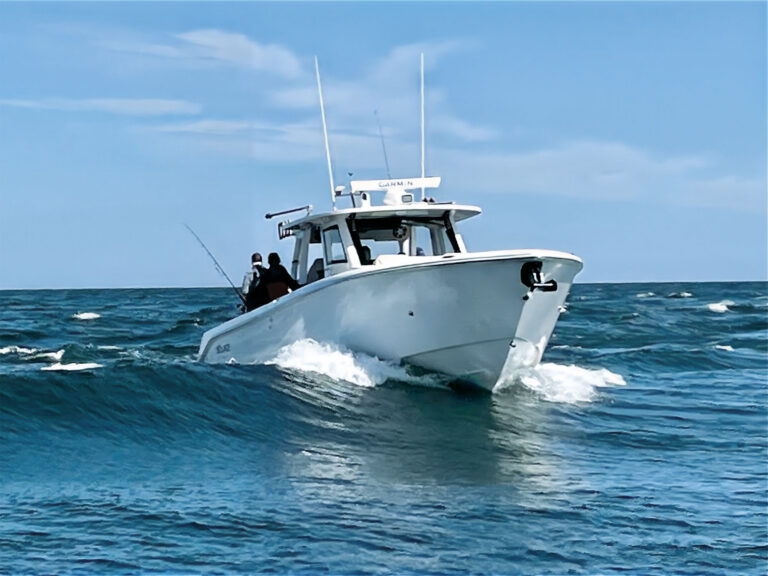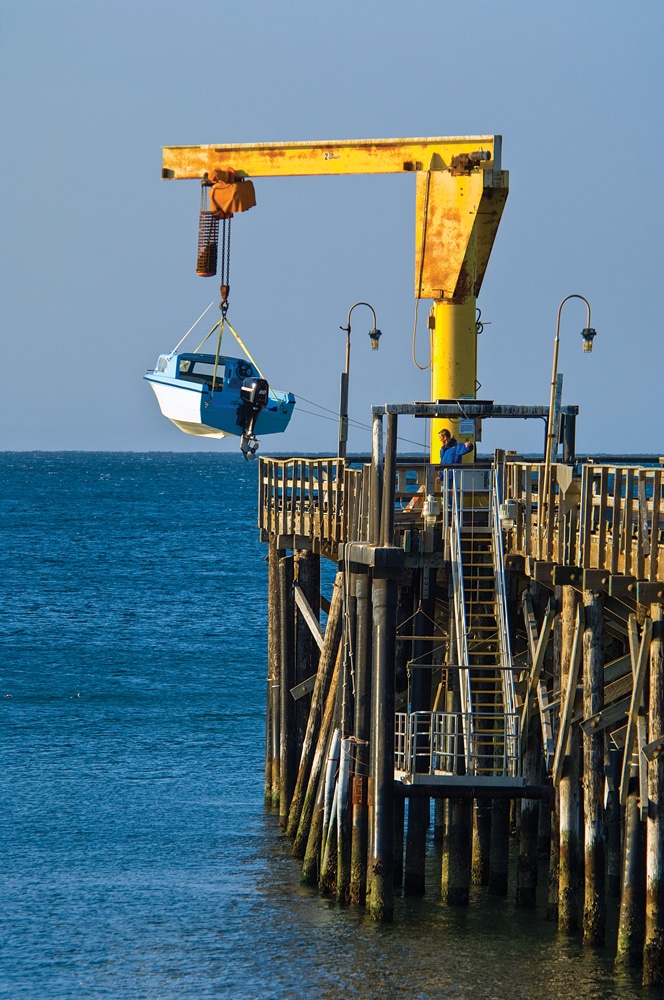
Extreme Boat Launches
Gaviota Beach, California Gary Crabbe/EnlightPhoto.com
No ramp? No problem, as long as you’re willing to punch through breakers, ride the surf or dangle your boat from a pier.
Do-It-Yourself Pier Dangle
Gaviota Beach, California
Pucker Factor: High
Popularity: Low
Difficulty: Moderate
Best Boat: Any craft under 21 feet and less than 2,000 pounds
Let’s start our tour of extreme launches 30 miles west of the tony coastal burg of Santa Barbara, where daring California boaters resort to a do-it-yourself boat hoist on a rustic wooden pier hammered by Pacific swells.
Operating since 1953, the Gaviota Pier crane has always been a uniquely freelance affair. The undertaking begins with rolling your trailer boat (without aid of a tow vehicle) out on the pier over aging planks to reach the crane.
Hang ‘Em High: You also have to bring your own three-strap sling and shackle it to the transom eyes and a lifting eye in the bow. Next, attach the crane hook and some long dock lines to stabilize your craft in midair; then hoist your pride and joy high enough to clear the rails and swing it out over the ocean, four breezy stories below.
If all goes well, one of your crew will greet the descending boat, climb in, start the engine, detach the hook and wait while you reel in the cable, muscle the trailer to the parking lot, trot back, descend the stairs to a platform, time the swells and climb aboard.
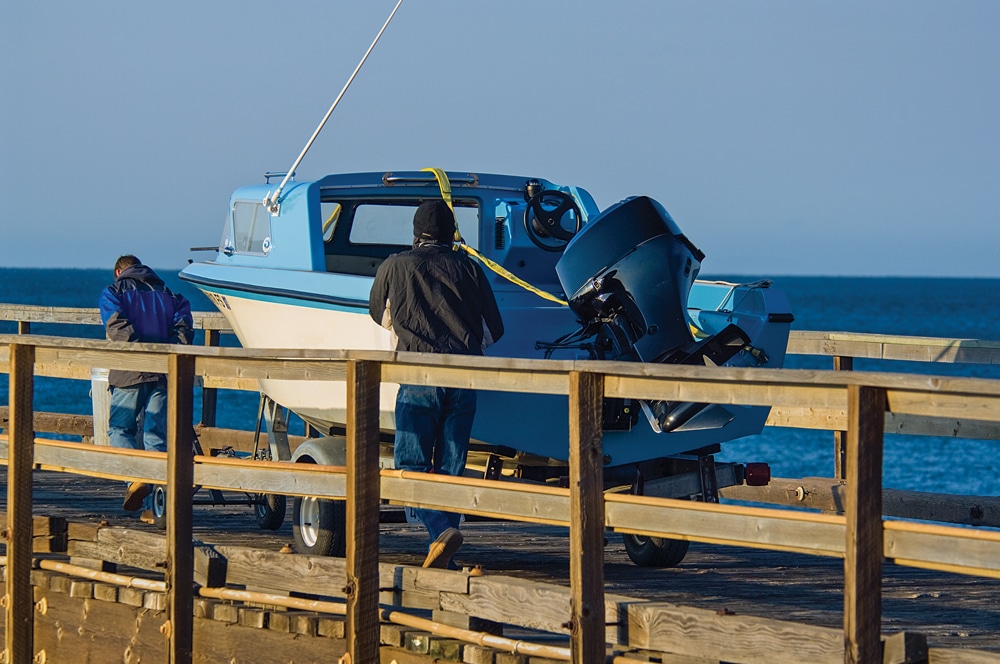
Extreme Boat Launches
Gaviota Beach, California Gary Crabbe/EnlightPhoto.com
Certifiable: Before 2006, it was truly the Wild West on the Gaviota Pier, because there was little regulation or supervision. Boaters launched at will amid monstrous ground swells and buffeting winds. After a few failed slings and issues with boaters damaging the crane, however, the California Department of Parks and Recreation instituted a certification program for boaters.
Today you need to go through a day of training, and your boat must pass an inspection that includes weighing it while full of fuel and gear, checking the sling and looking closely at all three lifting eyes.
You also have to prove that you’re prepared to overnight aboard your boat, because the parks department may well shut down the hoist during the day if winds or ocean swells happen to build to the point that retrieving a boat becomes too dangerous.
Risky Retrieval: The retrieval process can be more dicey than the descent, because the boater must now swing the boat inward over the pier, keep it from spinning and then lower it precisely onto the trailer without harming any crew members who might be standing by to help.
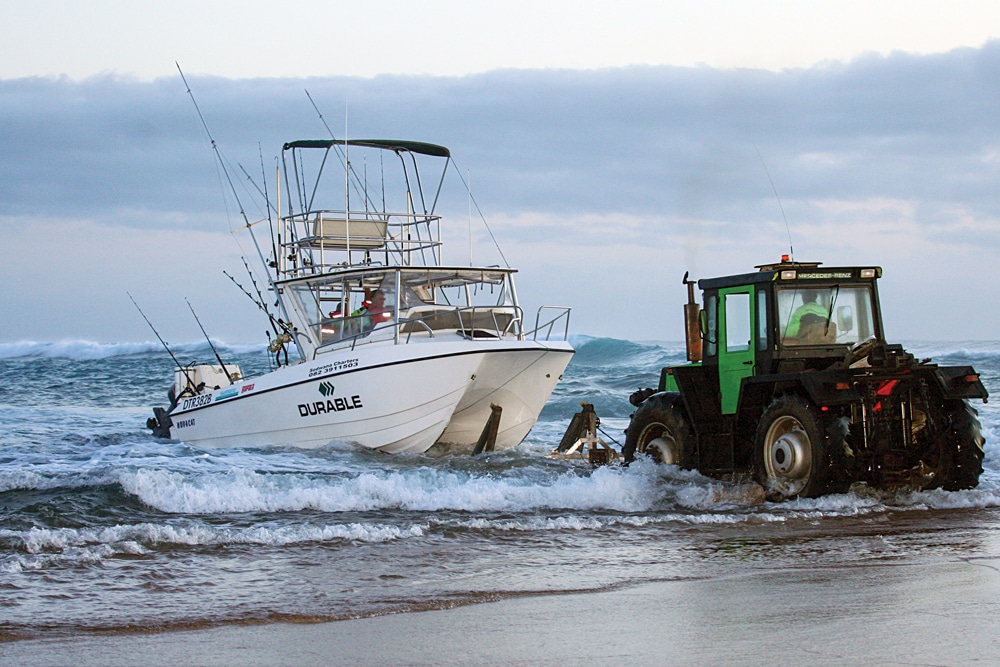
Extreme Boat Launches
Sodwana Bay, KwaZulu-Natal, South Africa James L. Dekker/Fotoman.co.za
African Cat Attack
Sodwana Bay, KwaZulu-Natal, South Africa
Pucker Factor: High
Popularity: Low
Difficulty: High
Best Boat: Power catamaran
From Swaziland down to Port Elizabeth, along some 750 miles of South Africa’s east coast, about the only way to put a boat to sea is through the relentless breakers of the Indian Ocean.
Here, a resilient core of boaters — mostly sport fishermen — have adapted to the dearth of harbors and ramps with methods that enable them to launch and retrieve power cats up to 29 feet in length through the pounding surf at locations such as Sodwana Bay.
South Africans use two specialized methods. One is to back the trailer boat down into the water using a four-wheel-drive truck or a tractor until the hull floats.
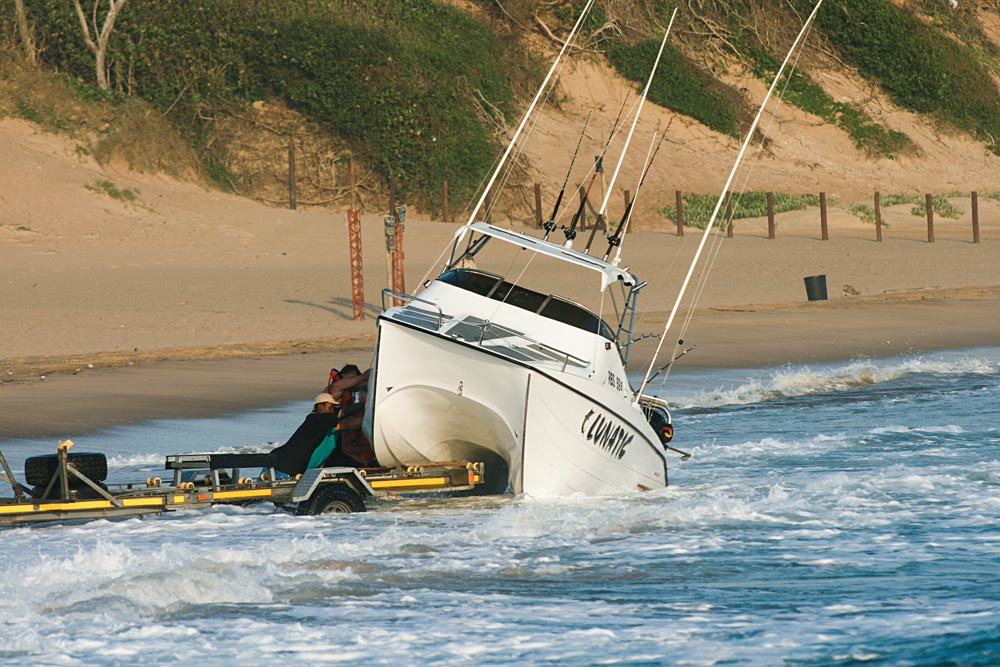
Extreme Boat Launches
Sodwana Bay, KwaZulu-Natal, South Africa James L. Dekker/Fotoman.co.za
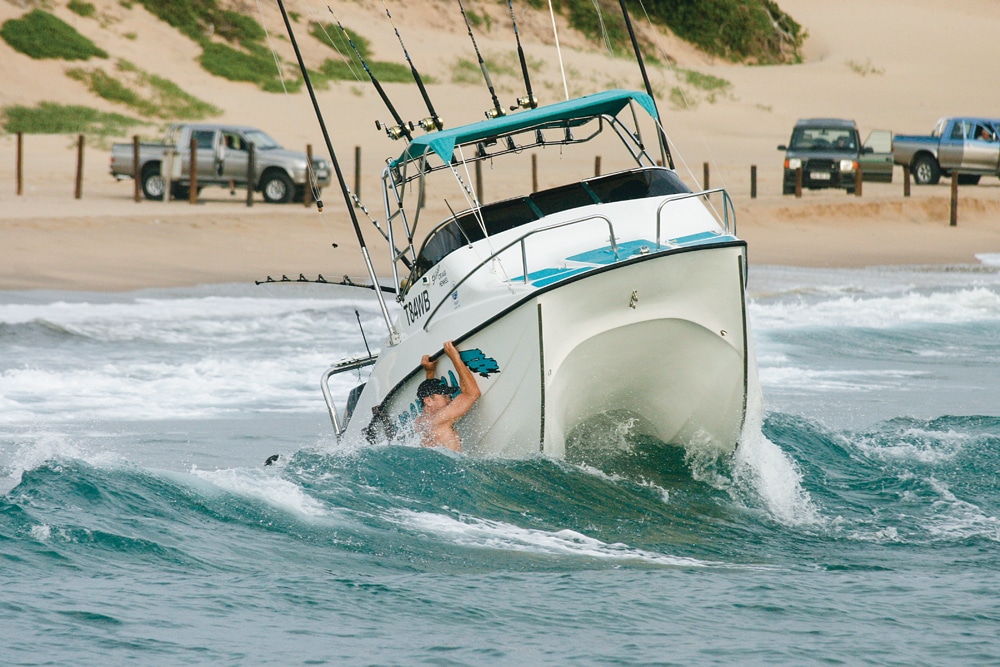
Extreme Boat Launches
Sodwana Bay, KwaZulu-Natal, South Africa James L. Dekker/Fotoman.co.za
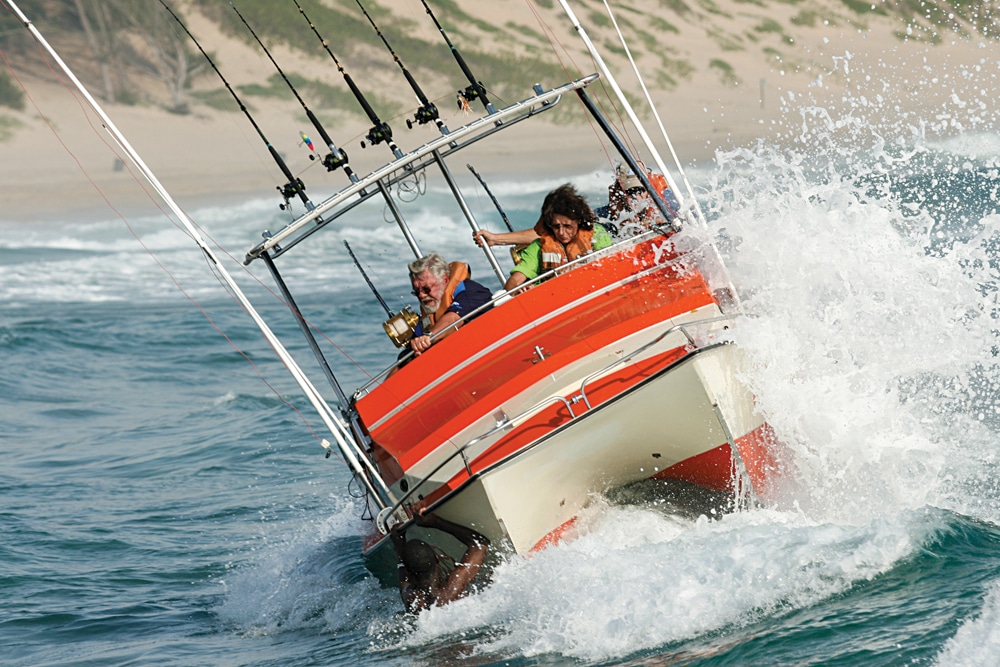
Extreme Boat Launches
Sodwana Bay, KwaZulu-Natal, South Africa James L. Dekker/Fotoman.co.za
Next comes the challenge of spinning the boat around to face the waves so the outboards can be tilted down and started. This task usually falls on the crew, who wade out to wrestle the boat into position without getting crushed by the hull or chewed up by the props. Once the engines are running, the crew must quickly clamber in over the sides, which are decidedly tall on these South African cats, before the boat washes sideways to the surf. Then everyone hangs on for dear life as the captain punches out of the surf zone through the breakers. It’s definitely a young man’s game.
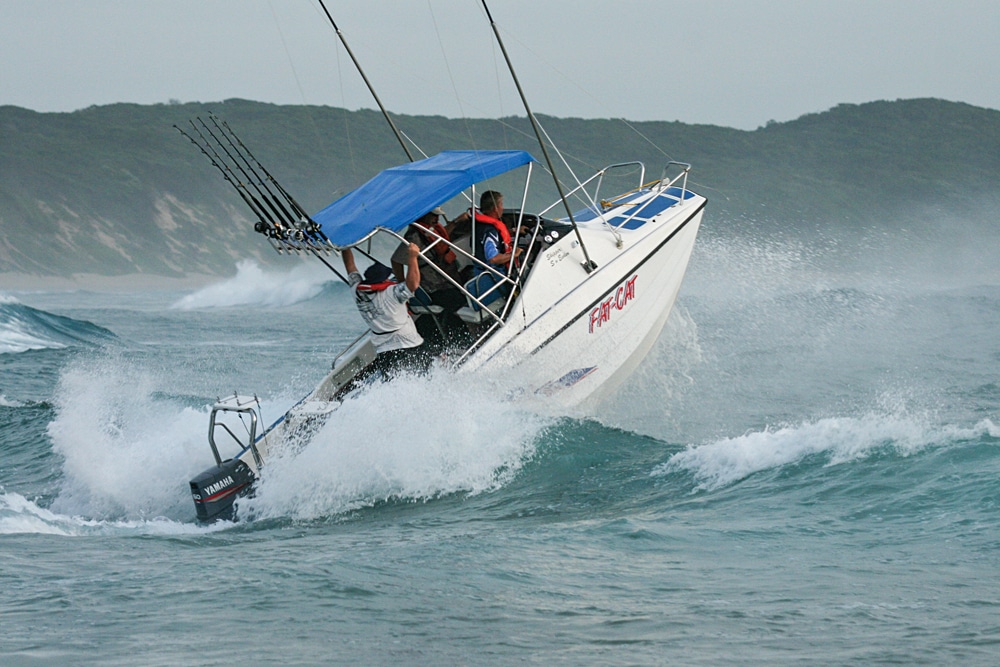
Extreme Boat Launches
Sodwana Bay, KwaZulu-Natal, South Africa James L. Dekker/Fotoman.co.za
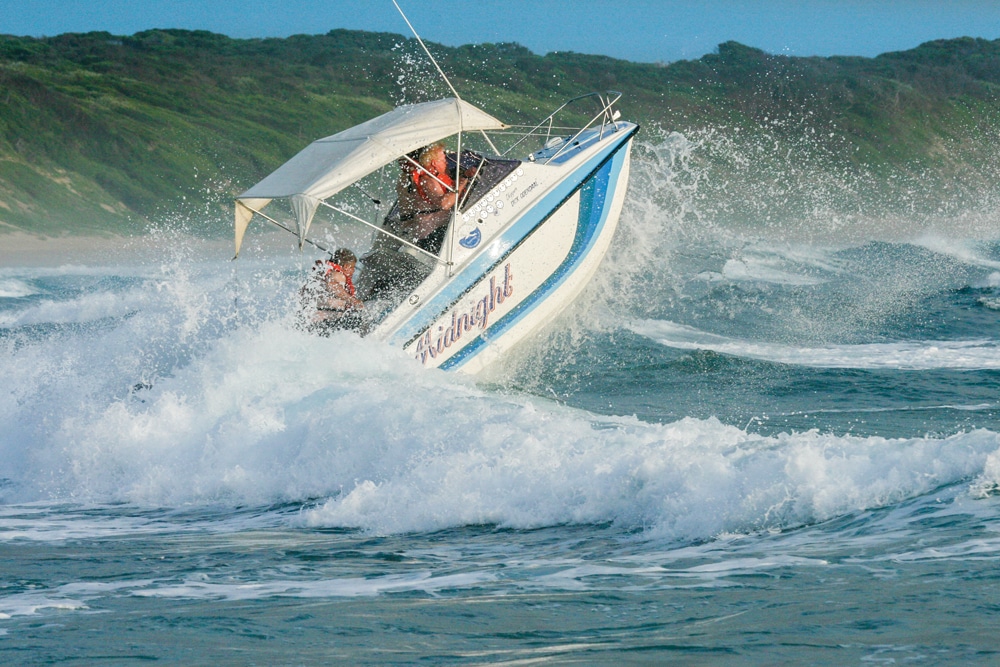
Extreme Boat Launches
Sodwana Bay, KwaZulu-Natal, South Africa James L. Dekker/Fotoman.co.za
Launch Bow-First: The other launch method is less conventional but seems safer and easier: a technique that uses a special single-axle trailer that allows the boat to be shoved into the shore wash bow first.
The axle is in the middle of the articulating roller trailer, and sometimes there are dual wheels on each end, with the sponsons nestled between the tires to support the boat on the sand.
Returning through the surf is usually easier than launching: Run as fast as you can through the waves and then slide your boat onto the sand, while tilting the outboards.
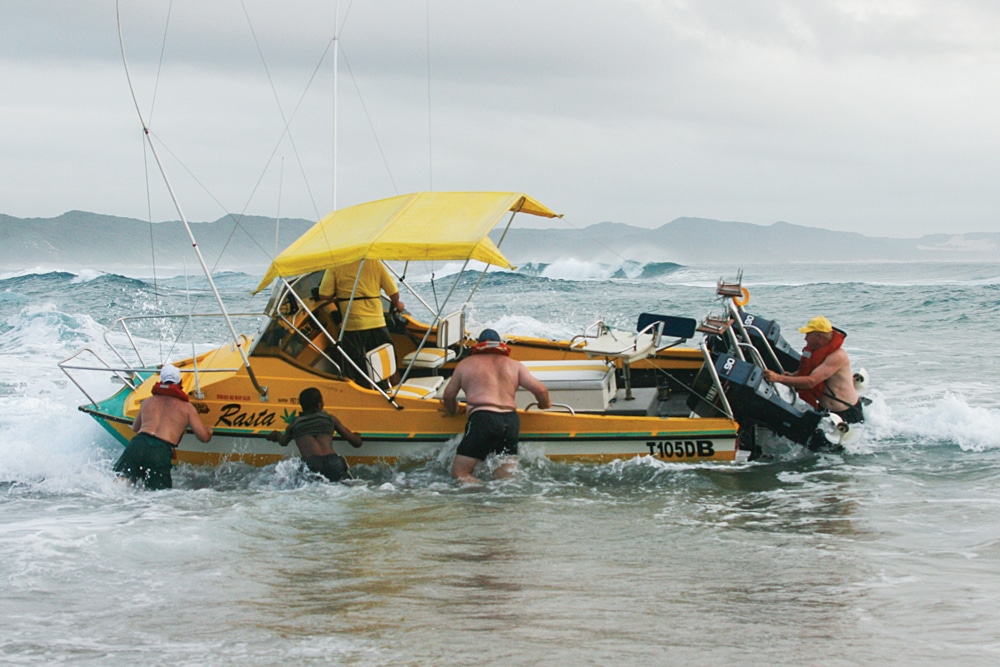
Extreme Boat Launches
Sodwana Bay, KwaZulu-Natal, South Africa James L. Dekker/Fotoman.co.za
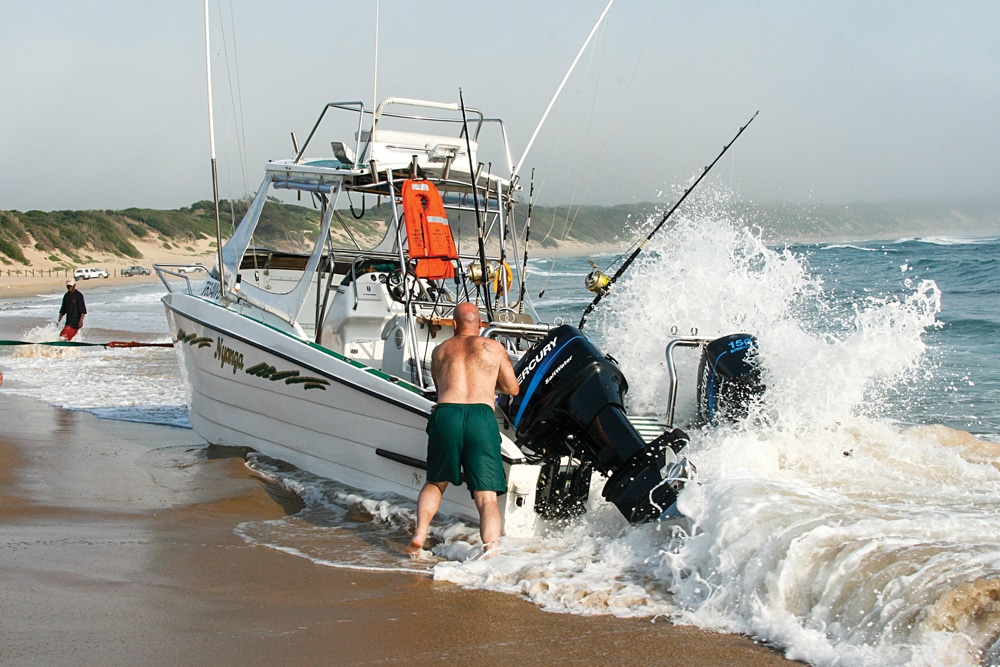
Extreme Boat Launches
Sodwana Bay, KwaZulu-Natal, South Africa James L. Dekker/Fotoman.co.za
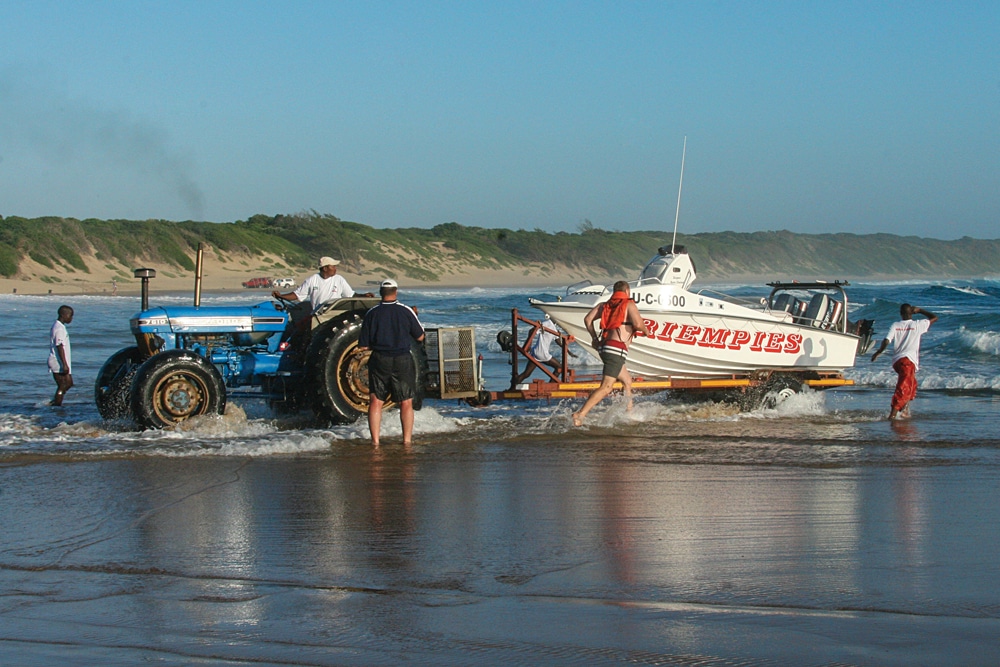
Extreme Boat Launches
Sodwana Bay, KwaZulu-Natal, South Africa James L. Dekker/Fotoman.co.za
Load It Up: Boats that launch stern-first get cranked onto trailers with a power winch. Boats that launch bow-first are spun around on the sand, usually with a truck and tow strap, before getting winched onto the trailer stern-first.
For many South African boaters, this is the only kind of boating they have ever known.
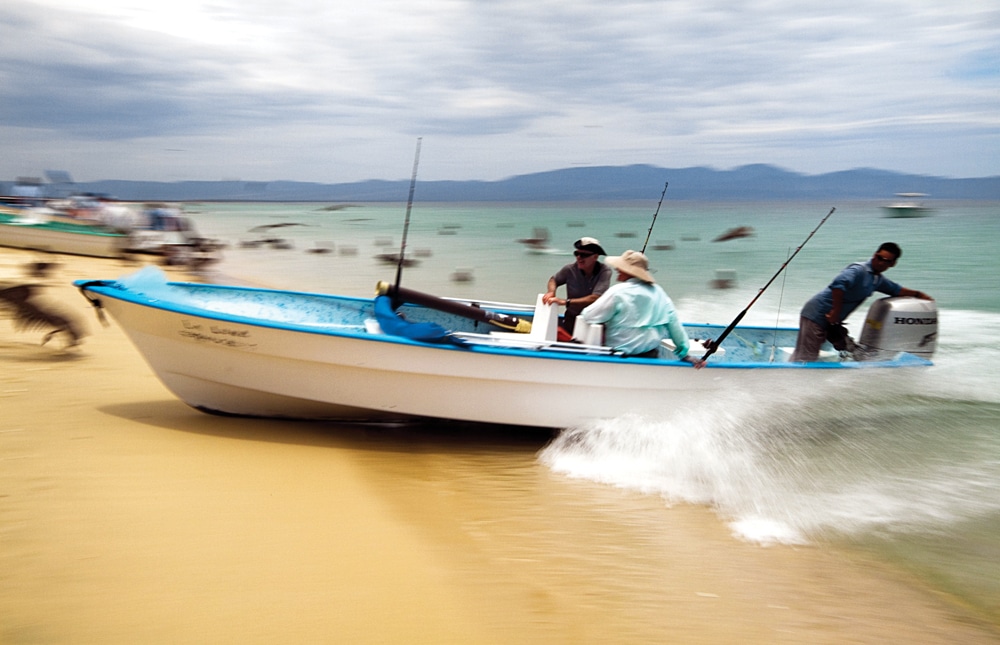
Extreme Boat Launches
Punta Arena, Baja California Sur, Mexico Tailhunter International LLC
Baja Beach Slide
Punta Arena, Baja California Sur, Mexico
Pucker Factor: High
Popularity: High
Difficulty: Moderate
Best Boat: Fiberglass panga
Beaches along the east coast of Baja California remain calm most of the time. With the surf relatively small, launching in the morning is simply a matter of asking your amigos to help shove your slender fiberglass panga down the sand bank and into the water until it floats. Nothing too extreme about that, especially since the water stays pretty temperate all year round.
But it’s the return trip in the afternoon that turns wild and injects your trip with a final dose of adrenaline. Nowhere does this play out with greater excitement or frequency than on the beach at Punta Arena, about 35 miles by road south of La Paz.
Hit The Beach: The first time I fished with a pangero out of Punta Arena, we had a great day, catching lots of pargo (snapper) and cabrilla (grouper) around Isla Cerralvo, a desert island just northeast of the point.
As we headed home, our guide stopped about 100 yards outside the beach and began arranging and securing gear. Then, with his best English and a few stern gestures, he cautioned us to move back as far as possible and hold on.
As my fishing buddy and I exchanged inquisitive glances, our guide wrenched the throttle on the tiller of the 75 hp outboard, suddenly pinning us in
our seats.
Hold Tight: The panga accelerated steadily. As we closed on the beach, I yelled over the wind blast, “He’s not slowing down!” Just as the bow met the sand, the guide killed the engine, gripping the back of the outboard cowl to keep from flying forward. We gringos maintained a white-knuckle grip on the gunwales and braced for impact as we slid 30 feet up the sand bank and the last “pop, pop” of the open exhaust announced our arrival.
Decelerating from 25 to 0 mph in 10 yards is more extreme than you might think, and so a few gringo fishermen end up in the bottom of the boat or suffering bruises or both while experiencing the famous Baja slide.
Labor Saving: This maneuver is pure fun. After all, how often do you get a chance to charge the beach at full speed and slide onto the sand? Yet to the pangeros, it’s part of a day’s work, saving them the hard labor of muscling a boat up the beach. But who says work can’t be fun?
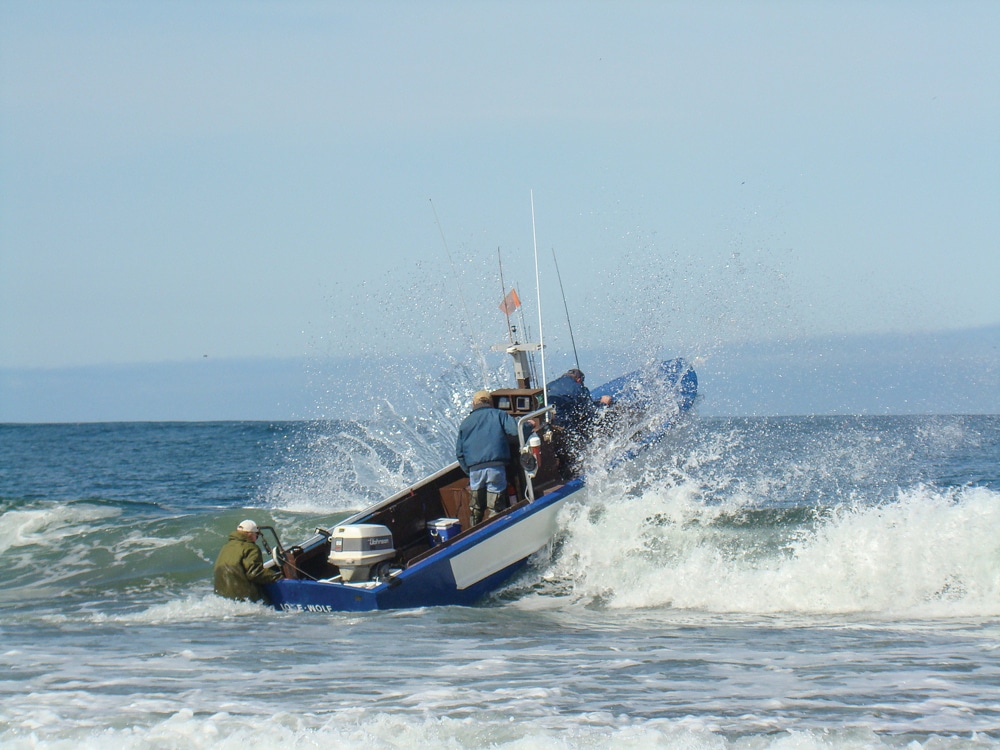
Extreme Boat Launches
Pacific City Beach, Oregon Sandy Weedman
Daring Dorymen
Pacific City Beach, Oregon
Pucker Factor: High
Popularity: High
Difficulty: High
Best Boat: 20- to 22-foot locally built wood dory
Yet, why surf launch? Why not use the ramp in, say, Tillamook? Firstly, the Tillamook launch ramp is 30 miles away, and the seas in between are often snotty. Secondly, the best fishing for halibut, lingcod and rockfish is just a quarter-mile off Pacific City Beach. So bustin’ out through the surf sounds like a reasonable option.
Wood’s Good: “The best dory is a wood dory,” says doryman Bruce Polley. “It’s lighter than fiberglass and easier to muscle around.” While there are fiberglass dories, most used for this unique technique are in the 20- to 22-foot range and built by local custom shops.
Cape Kiwanda protects the beach from northwest swells, and a paved ramp lets you back your trailer over the dry sand before reaching the packed sand. You launch the boat by shoving it off its roller trailer into the suds, and while one crew member spins the boat around and holds it in the shore wash, the other parks the trailer.
That’s dicey enough, but things gets extreme when it’s time to push out. Crews manhandle their boats until they’re deep enough and then hop in and hope the engine starts. Skippers time the waves to avoid catastrophe but regularly get pounded by the rolling surf.
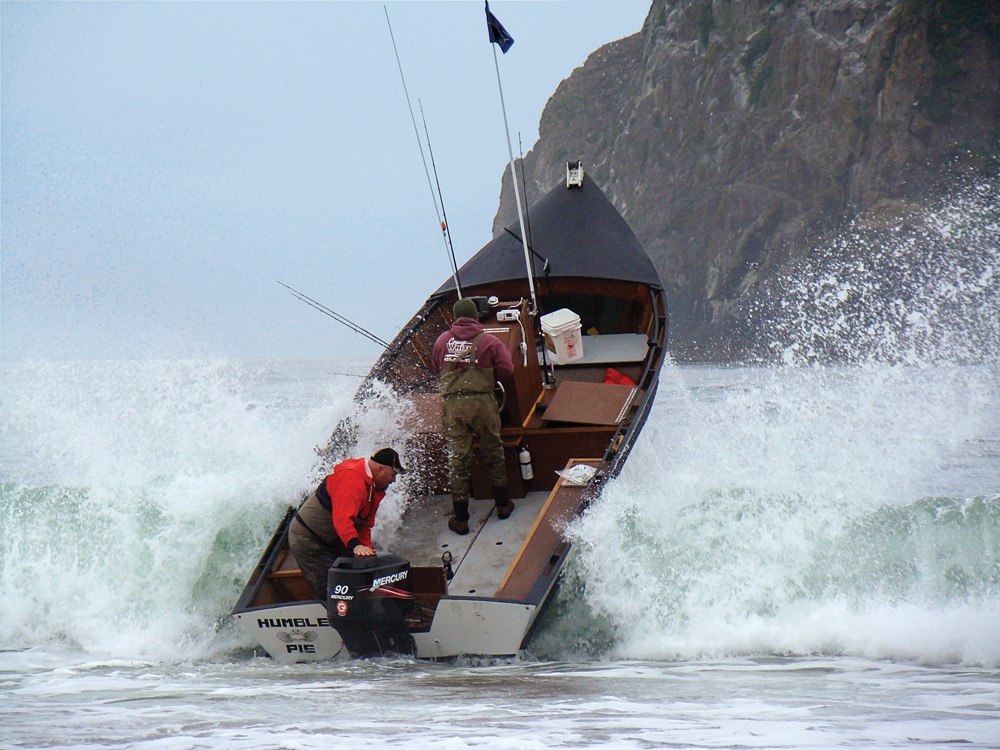
Extreme Boat Launches
Pacific City Beach, Oregon Sandy Weedman
Surfin’ USA: Running back in is a matter of picking a wave and staying behind it until the boat slides onto the sand. Judicial use of the outboard trim keeps the lower unit from dragging. In case of engine failure, you’ll need to row back in, albeit backwards to keep the bow to the waves.
Crews use tow straps to pull beached boats to firmer sand, and then back a roller trailer under the bow and winch up the boat. Unconventional, for sure, but all in a day of fishing for the dorymen of Pacific City Beach.
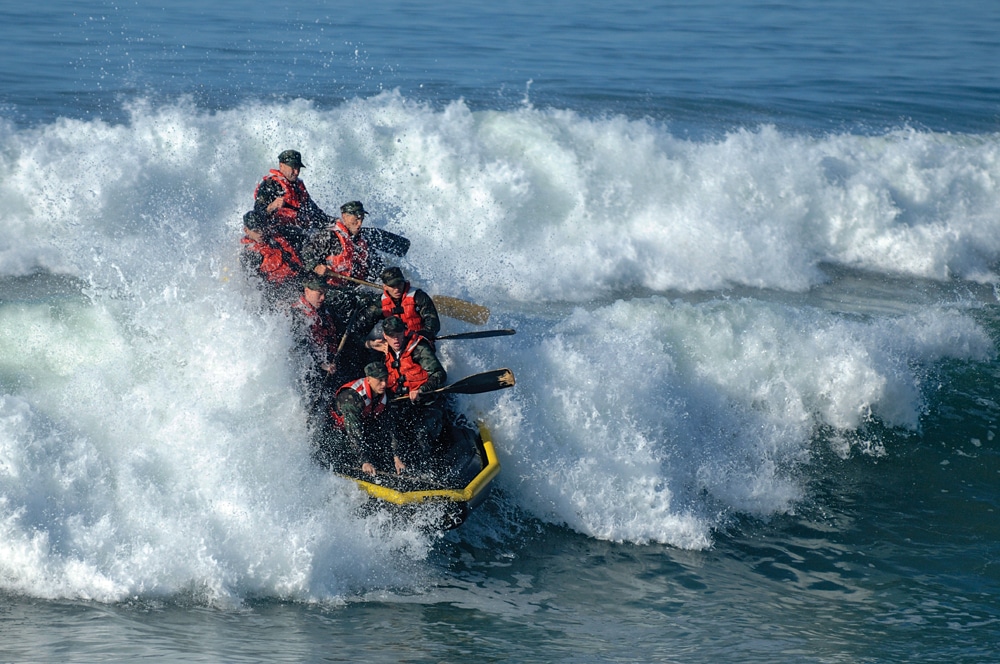
Extreme Boat Launches
Seal Sub Launch
Pucker Factor: High (even for members of Seal Team 6)
Popularity: Very low
Difficulty: Very high
Best Boat: 12-foot roll-up inflatable
U.S. Navy Seals execute the most extreme boat launch of all. They push a 12-foot inflatable and motor out of a submerged submarine and then follow it up to the surface.
Former U.S. Navy Seal Ed Thelander trained other Seals in this technique. “We used a Zodiac F470 roll-up, which was the biggest inflatable we could fit through the interlock chamber,” he says. “We still had to fold the boat up taco-style to shove it through the hatch.”
The Seals’ outboard of choice is a 35 hp Evinrude two-stroke with a special valve system to keep water out, but they take a spare just in case.
“Sometimes we launch boats with parachutes out the back of C-130 aircraft,” Thelander says, “but the sub launches are more stealthy.”
To make it tougher, all takes place at night, and then the Seals need to run the boat in through the surf and then punch back out to meet the sub. “We’ve taken a few tumbles,” he admits. “It’s part of the learning curve.”
Extreme Boat Launch Videos
Check out this collection of favorite videos of wild boat launches and landings from South Africa, Oregon and Mexico.





